fall03
Back to VCBS First Page
INSIDE THIS ISSUE:
Four Vermont Covered Bridges to Receive Grants TV Station Wants Unique Covered Bridge Photos
Vermont History EXPO 2003 Has Come and Gone Montgomery Hectorville Bridge Project
Hammond Bridge Called Unsafe Sanderson Bridge Back in Business Phil Pierce to Present at MIT Investigator Says No Arson At Sanderson Bridge Arson Attempt on Henry Bridge A Passing - Jim Fearon
Covered Bridge Community News Notes Gorham Bridge Renovation Letters -- "Romantic Shelter" Lost
Membership Column President's Column Covered Bridge Postcards For Sale Covered Bridge - a poem
|
by Joe Nelson Bennington, June 14, 2003 - The Vermont Covered Bridge Museum officially opened on this day at 10 a.m., described by entrepreneur Bruce Laumeister as the world's first.
Among the museum's exhibits are a working HO Gauge railroad and covered bridge layout and an interactive kiosk describing covered bridges of Vermont. The covered bridge resource center contains the collected writings of Richard Sanders Allen and covered bridges described in all of their aspects through artful display of models and photographs galore of bridges past and present. The Archives of the National Society for the Preservation of Covered Bridges provided an important share of the exhibits. The Museum was planned and the exhibits assembled by the Center staff under the guidance and direction of Bennington historian John Dostal and the talented efforts of Emiliano DeLaurentis, founder of Knowledge Environments, Inc. of North Adams, Mass. Also deeply involved in the planning and coordination of the effort was Curator Robert Campanile, former director of the North Adams Museum of History and Science. The festivities began with the opening of Gallery III exhibit "Art of the Animal Kingdom" followed by a live raptor demonstration by the Vermont Institute of Natural Science. Attendees were entertained by the music of the Flying Garbanzos from noon to two. The afternoon saw an introduction of Bruce Laumeister by Vermont House Representative Joe Krawczyk, an address by Robert Campanile, some words from John Dostal, and a showing of the Video Film Documentary Covered Bridges of Vermont, directed by Emiliano DeLaurentis. The ceremonies continued with the recitation of his poem by author and poet Ed Barna, comments by Joe Nelson, president of the Vermont Covered Bridge Society, and entertainment by Eric Peterson and Willy Jones of the Oldcastle Theatre Company; "Yankee Traditions." The celebration was concluded with comments by Vermont Governor, James Douglas. Return to Top by Joe Nelson The VCBS Fourth Annual All-member Business Meeting will be held Saturday, October 25, at 10 a.m. in Middlebury's Ilsley Public Library in downtown Middlebury, next to a municipal parking lot. Irene Barna has arranged for us to use the All Purpose Community Room. Richard Wilson, President of the New York State Covered Bridge Society and member of the VCBS Board of Directors, will be our speaker. He will give a slide presentation, "The Changing Scene with Vermont Covered Bridges." The meeting will be followed by a tour of the area covered bridges conducted by Ed Barna, a founding member of the VCBS. Ed is a poet and the author of Covered Bridges of Vermont, published by The Countryman Press. Attendees will dine on own at local restaurants. The meeting agenda with directions to the meeting place, ballots for the annual election of officers, and a list of motel accommodations will be mailed and emailed to the membership shortly. [Call the Middlebury Chamber of Commerce for a list of area lodgings. The phone number is 1-802-388-7951-Ed.] Return to Top by Joe Nelson July 16, 2003 - Susan Scribner of the VAOT Historic Bridge Program e-mailed that the Vermont Department of Transportation proposed projects to the Federal Highway Administration totaled $2 million. The requested funds, provided through the National Covered Bridge Preservation Program, authored by Sen. James Jeffords in 1998, will be shared by four of Vermont's covered bridges. "Apparently," said Scribner, "the $2 million figure requested for federal funds was reduced to $1,987,000 so we will need to make an adjustment of $13,000 to one or more of the covered bridge projects. The project costs that were estimated included all associated costs including engineering, right-of-way acquisition if needed and construction oversight." The total estimated project cost for the Thetford Sayers bridge is $500,000. The requested federal funds were $400,000 along with $100,000 in state and local funds. The total estimated project cost for the Salisbury Station bridge is $850,000. The requested federal funds were $680,000 along with $170,000 in state and local funds. The total estimated project cost for the Upper Falls (Downers) bridge is $750,000. The requested federal fundswere $600,000 alongwith $150,000 in state and local funds. The total estimated project cost for the Cilley bridge is $400,000. The requested federal funds were $320,000 along with $80,000 in state and local funds.
The Sayers Bridge [45-09-06] is known
for its "Haupt" truss, the only truss of its kind in New England, and one of just three in the United
States. The truss used in the span is a unique adaptation of Herman Haupt's 1839 patent.
The 154-foot Salisbury Station Bridge
[45-01-01] spans Otter Creek on Swamp Road at the edge of the Great Cedar Swamp. It has
been known as the Cedar Swamp Bridge, the Salisbury Station Bridge, or simply as the Station
Bridge. The Upper Falls, or Downers Covered
Bridge [45-14-08] was built cl840, the portals finished in the Greek Revival mode. Partial
cornice returns and enclosed roof-end overhang bracket the splined gable-end boarding. The
treatment simulates the Greek pediments in the Federal architecture popular in the first half of the
1800s. Downers Bridge is Vermont's last example of splined boarding in a bridge portal.
The 121-foot plank-lattice span crosses high over the Black River. The tall stone abutments and
long curved wingwalls are the most impressive examples of dry stone masonry in the state. The
northern abutment has not been cased in concrete and remains a tribute to the skill of the
masons.
Neil Daniels, member of the Weathersfield Transportation Advisory Committee and chairman of the Weathersfield Chapter of the Vermont Covered Bridge Society said the bridge has rot in the lower chords not removed in the 1975 rebuild. Instead, a fifth lower chord member was added (a town lattice truss normally uses four chords; upper and lower chords, and upper and lower secondary chords). The south abutment, where the dry laid stone can still be seen, needs attention. The north abutment concrete facing is severely eroded. The exterior of the bridge needs attention, including a new roof.
The Cilley Bridge (45-09-08] was built in 1883 using the multiple-kingpost truss. The 60 foot bridge spans the First Branch of the White River in Tunbridge, serving Howe Lane, It stands among corn fields in view of Route 110 just south of Tunbridge Village. An old cemetery nearby adds to the ambiance of the site. The bridge is unique in the construction of the tie-beams and the doubled knee-braces. A new roof, funded by a Federal program, was installed in the late fall, 2002. Return to Top by Rich Remsberg WTIU-TV (the Bloomington, Indiana PBS station) is producing a documentary on covered bridges and is looking for interesting visual materials. We are interested in vintage photos, film footage, and so forth that show covered bridges as a cultural icon. We have plenty of material that shows bridges in a scenic or structural context, but we'd like to find images of weddings, church suppers, and the like on or near covered bridges. We would also be interested in any pictures that show daredevils jumping from covered bridges and that sort of thing. Also, we are looking for any cartoons, advertisements, and other graphics that show covered bridges. If you would be willing to share items from your collection, please contact Rich Remsberg, 406 S. Madison, Bloomington, IN 47403. 812-335-1310 rich@remsbergphoto.com Return to Top By Irene Barna An enormous and never-can-be-adequately expressed THANK YOU goes out to John Dostal who spent hours on his feet among the passers-by of the VCBS booth inquiring of them what they might know of by-gone covered bridges in their town. John was single handedly instrumental in getting our work-in-progress map of the by-gone bridges of Vermont started. He acquired the 3'x4' map of Vermont onto which he has started marking the locations of bridges that can be recollected and documented. No easy task. But how was Expo 2003? It was the usual GREAT, well attended. The weather cooperated this year without substantial rain. The VCBS booth was again in the Floral Hall and thanks go to Joe Nelson and John Dostal who helped in the set up on Friday, then both working at the booth. John Weaver, Wilfred Thompson, Bill McKone, and Irene Barna completed the staffing of the booth Saturday and Sunday. What did we display in addition to the map? We had treenails, examples of original timber showing old-growth rings compared to more recent wood; both from the Sanderson Bridge in Brandon, a breast-drill, and a nice selection of prints and copies of art work by John Weaver and photos by Joe Nelson. Will we do it again next year? I hope so. Plans are already being made by the Vermont Historical Society for the Fifth Annual Vermont History Expo in Tunbridge. The date is yet to be announced, but it will likely be that third weekend in June again. Return to Top by Scott Perry
But with bragging rights also comes obligations and costs, and since two of the town's bridges no longer serve vehicular traffic (the Hectorville or Gibou Bridge, and the Creamery or West Hill Bridge), the costs associated with their upkeep and renovation fall to the town's approximately 900 taxpayers. These costs compete with all other municipal needs; schools, water, roads etc., so it's not surprising the condition of these two bridges has deteriorated over time. A couple of years ago the Montgomery Historical Society took the initiative to hire an engineer to study these two bridges and develop recommendations on what the town should do. Of the two, the engineer said the Hectorville Bridge was in the worst shape and would likely fall into the South Branch of the Trout River if it wasn't taken down before last winter. The Historical Society made a recommendation to the Selectboard and with generous support raised the funds necessary to disassemble the bridge and put it into storage until its fate could be determined.
This group has been meeting since May and is building on work by a similar ad hoc group formed by the Historical Society that worked through the winter. Options under consideration are to repair the bridge and return it to the Hectorville site on the Gibou Road, or to repair the bridge and relocate it to an area of town that would integrate it into a recreation path. (this bridge was originally located in Montgomery Village and was moved to the Hectorville site in the early 1900's). Of these options, the latter has garnered the most enthusiasm on the committee because it could put the bridge in plain view on a main thoroughfare and make it eligible for several State and Federal programs related to recreational use, easing the financial burden on the taxpayers. In the future we hope to provide progress reports via the town web site at http://www.vermont-towns.org/montgomery/. Advice and any other comments may be made by e-mailing the webmaster at this page or by writing the Hectorville Bridge Committee, or Selectboard, c/o the Town Clerk. Tax deductible contributions will be gratefully accepted also and can be sent to: Hectorville Bridge Fund, Town Clerk/Treasurer, P.O.Box 356, Montgomery, Vermont 05471 Return to Top by Ed Barna, Rutland Herald Correspondent Pittsford, August 17, 2003 - The Hammond Covered Bridge, [WGN VT-11-05] overdue for repairs, is too dangerous even for pedestrian traffic, according to state historic preservation officials.
According to covered bridge builder Jan Lewandoski of Stannard, a wooden bridge's own dead load is the heaviest weight it has to carry, and is always its biggest problem. Through the years, the Hammond bridge has been subject to what engineers call "creep," a gradual increase in its downward deflection. Well maintained covered bridges compensate with a slight upward bend, known as camber, but this 139-foot bridge has lost its camber entirely and is a visibly sagging. Also, according to Eric Gilbertson, deputy director of the Division for Historic Preservation, the bridge has also developed a twist. "Snaky" was a his word to describe the shape of the 161-year-old structure. "There are holes in the floor," added Margaret Armitage, a member of the Pittsford Historical Society. One reason for its condition might have to do with its history. During the 1927 flood, the bridge floated downstream about a mile to the Pomainville farm. It was floated on barrels back to its original crossing and put back into use. Gilbertson and John Dumville, the state's historic sites coordinator, both said they have tried for two sessions to get the Legislature to approve funds for stabilizing and then rehabilitating the Hammond bridge. But now it is in such bad shape, they said, that a heavy snow load next winter--or a large group of tourists tramping across--could send it into the river. Asked how many people he thought the bridge could safely take, Gilbert's fast answer was "none." He then added, "I couldn't say absolutely." The Hammond site is a likely tour bus stop because it has a large parking area, a state interpretive sign, and it leads to a historic trail on the other side of Otter Creek. The trail goes toward the Revolutionary War site of the former Fort Mott and the shallow area-"Pitt s Ford," General Jeffrey Amherst named it--where troops could cross before there were any bridges. As for the Hammond bridge, Gilbert said, "I thought we had closed that off. People weren't supposed to go on it." But Armitage said an inspection Friday showed only a chain between two posts meant to keep vehicles off. "No signs saying 'No Trespassing' or 'No Pedestrians,'" she said. "It hasn't changed at all." [This article first appeared in the Rutland Herald Rutland, Vt., Aug. 17, 2003. Ed Barna is a member of the Vermont Covered Bridge Society and author of the book Covered Bridges of Vermont, Countryman Press - Ed.] Return to Top by Ed Barna, Rutland Herald Correspondent Brandon , July 31, 2003 - The Sanderson Covered Bridge over Otter Creek, a link between Brandon and Sudbury, has reopened for traffic after 14 years. During the past year, the 163-year-old, 132-foot structure has been overhauled by Blow & Cote Construction Co. of Morrisville. The project has been characterized as more of a bridge replacement than a repair job, with only a few of the original timbers and planks remaining. Voters decided at town meeting to rebuild the bridge rather than pay the high archaeology costs necessary to establish a new road to a new crossing and a modern bridge. Thus the span has been reinforced with glue-laminated timbers to carry up to 40,000 pounds. Town Manager Michael Balch said at a Select Board meeting Monday that the posted limit will be 24,000 pounds, but he will issue permits for heavier vehicles to cross as necessary. Selectman Richard Baker urged that improved signs be posted at the west end, where motorists come upon the single-lane bridge very abruptly. Balch said he would try to get stronger warning signs put up, but said "it really is the state's responsibility." He said if there is an accident, "we want it to be the state's liability, not the town's." Some sort of official ceremony will be conducted later to take note of the bridge returning to use after being closed on state orders for 14 years, Balch said. A temporary bridge, on two large steel girders, has carried traffic during that time. Balch said the final bill for the work has yet to come from the state, but Brandon will pay 5 percent of $1.2 million to $1.3 million, or $60,000 to 65,000. Also, the Stone Mill Dam Bridge Road off Route 73 east was reopened following bridge repairs. [This story appeared in the Rutland Herald on July 31, 2003 - Ed.] Return to Top Phil Pierce has been invited to make a 2 hour presentation for the Boston Society of Civil Engineers on the evening of November 12, 2003. This is the 6th in their 7 part series, "This Olde Structure" and is entitled "Rehabilitation of Covered Bridges". The lecture series is held at MIT in downtown Boston. Anyone interested in attending should contact Scott Civjan at the Department of Civil and Environmental Engineering at (413)545-2521 or Civian@ecs.umass.edu Mr. Pierce is a life member of the Vermont Covered Bridge Society. Return to Top by Ed Barna Brandon, VT - After a recent unsuccessful attempt to burn Bennington's Henry Covered Bridge, it seemed reasonable to think that the newly rebuilt Sanderson Covered Bridge in Brandon might be a similar target. "Arson attempt on new Brandon bridge," said an Aug. 2 headline in the Addison Eagle. Workers for the Blow & Cote construction company had found a partially burned sock, wrapped in twine, on July 28--which the article characterized as "a charred homemade fuse." Debbie Bezio (buh-ZYE-oh), the president and engineer of Lone Wolf Drilling and Blasting in Benson, confirmed that the workers on the site had found the sock and thought it looked like fuse--though the Brandon police were not notified until Bezio did so. Bezio said she had been at the site because blasting was needed to remove foundations for the two steel girders that supported a temporary roadway across the river while the covered bridge was closed. According to Brandon Chief of Police Craig Hanson, the matter was turned over to the State Police. But when State Police fire investigator Dennis Holman reviewed the evidence and the bridge area, he concluded that the fuse wasn't connected to anything but rumors. "Its a real stretch to call it an attempted arson," Holman said. He said it was more probable that the sock had fallen off some kind of vehicle, perhaps a farm wagon being taken along the farm road north of the bridge--the area where it was found. Hay had been put on the ground to help reseed the work area, Holman said. None of that hay had been ignited where the sock landed, he said. A close inspection of the bridge and the two portal areas found no evidence of any sort of arson, Holman said. Had someone made an attempt, it probably would have been futile, he said, because the bridge has been treated with a fire retardant. That precaution, which had also been taken with the old Sanderson Covered Bridge during the 14 years it was closed, was taken after the town lost Deans Covered Bridge (Union Street) due to arson in 1986. A concrete bridge was chosen for that crossing, in a town meeting vote. Of more concern to Holman was the way the western approach to the bridge (from Sudbury going into Brandon) leaves so little time to see an oncoming vehicle. At the most recent Select Board meeting, board member Richard Baker expressed the same concern. The board agreed that there ought to be stronger signs along the approach, but could only advise Town Manager Michael Balch to talk with the state about it because such signs are a state responsibility. Balch said he would, because if there is an accident "we want it to be the state"s liability, not the town's." The final bills have not come in for the Sanderson reconstruction, but Balch said the total will be about $1.2-1.4 million, of which $60-65,000 will be the local share. Federal covered bridge money obtained by Sen. James Jeffords will pay $450,000 of the cost. [This article written for the Valley Voice by Ed Barna - Ed.] Return to Top Bennington, July 11, 2003 - According to Bennington Banner news, gasoline was dumped on the floor of the Henry Bridge Wednesday night and set on fire.
Three people saw flames and called police. A fire truck was sent to check the town's other two covered bridges and no problems found. The town has been looking into using a fire retardant for application to the town's bridges at the suggestion of John Dostal of Bennington, a member of the Vermont Covered Bridge Society and the man behind the Covered Bridge Museum, which opened at the Bennington Center for the Arts in June. The 120-foot Town Truss Henry Bridge spans the Walloomsac River serving Murphy Road in North Bennington. The original covered bridge, which served a local iron smelter, was built circa 1840. It was famed as the strongest bridge in the state due to its doubled truss, not replicated when the bridge was rebuilt in 1989. The bridge is named for the Henry family long in residence adjacent to the bridge. The Henry home is now a B&B. There has been a wooden bridge at this site since early times. [This news item is gleaned in part from the Bennington Banner, forwarded by Thomas E. Walczak - Ed.] Return to Top by Joe Nelson Vermont Covered Bridge Society member Jim Fearon of Lyndonville Vermont passed away Tuesday, June 24. Services were held on the 27th in Lyndon's School House Covered Bridge. Jim Fearon realized the value of his town's covered bridges and as a member of the Lyndonville Chamber of Commerce he chaired a committee to see that the bridges received the maintenance they needed. He recruited volunteers to do the work, sweeping, painting and clearing brush. His campaign made the town's covered bridges a centerpiece for many of the town's celebrations and activities, declaring Lyndon to be the "Covered Bridge Capitol of the Northeast Kingdom." Jim joined the VCBS having already created a Bridge-watch area in the best sense of the word. He served on the Board of Directors as chairman of the Lyndon Chapter and hosted the first VCBS All-member meeting in the Spring of 2000. He will be missed by all who knew him. He is survived by his wife Mary and two sons. Cards may be sent to 259 South Wheelock Road, Lyndonville, VT 05851-8412. Return to Top Oregon Bridge Collapses Noah Carolina Bridge Washed Out by Joe Nelson Pittsford-Proctor, Aug. 19, 2003 - The Gorham Bridge renovation is well underway. Rotted upper chord members have been replaced with native spruce, the upper bottom chords have been replaced with southern yellow pine. Thirty-four lattice planks found by the inspection and marked in the contract drawings for removal were replaced with southern yellow pine. Twelve others requiring replacement were found by the contractor and replaced with native spruce.
Formerly of corrugated steel, the roof will be replaced with galvanized standing seam metal. The new roof will have an eave overhang of at least one foot, requiring that the original roof rafters be replaced with longer members; the original roof system had no eave overhang, and with the siding cut short of the eaves to provide ventilation, the upper chords and lattice were exposed to the weather. All of the knee-braces will be replaced and installed at five-foot intervals instead of ten, and they will be fastened with lags instead of spikes. Borings demonstrated that there is very poor soil under the abutments, so these are being replaced with cast-in-place concrete on driven piles. The cast concrete will be faced to give an original appearance. Work began in May, 2003 with a completion date in early November. The cost of the project is currently estimated to be $1,243,788. The funds were received from the National Historic Covered Bridge Preservation Program. The prime contractor is Contractors Crane Service of Morrisville, the truss work is being done by Groton Timber Work, and the abutments by H.B. Fleming of Maine. The Gorham Bridge is owned jointly by the towns of Pittsford and Proctor. It was built in 1841 by Abraham Owen and Nicholas Powers. It is 114' 2" in length in a single span, using the Town lattice truss. The bridge was rehabilitated in 1956 and again in 1979. Return to Top
August 25, 2003 - When at camp, we visited Chester. We took Route 11 between Londonderry and Chester. Along that route, there was a private covered bridge right off the main road that went to a private home. We found that the bridge had been washed away three weeks ago in a flash flood. We found the truss and roof washed downstream and destroyed. Only the abutments are left and the people can't get to their home. I never knew the name of the bridge, but we saw it every time we went to Chester. It was built in the early 1990's, so it would not be in the guide to Romantic Shelters. It was located in North Windham. In the Vermont Atlas, Map 11. Follow Route 11 to North Windham. Just below the route 11 sign, is a small drive way. That's where the bridge was located. One half of the sign on the side of the bridge says Londonderry, the other half says Windham. The bridge was on the town line, as you can see in the Atlas. I photographed it in the Spring of 1997. Dick Wilson Return to Top
|
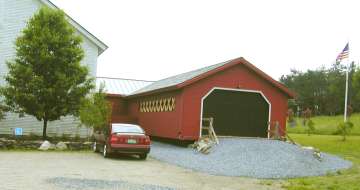

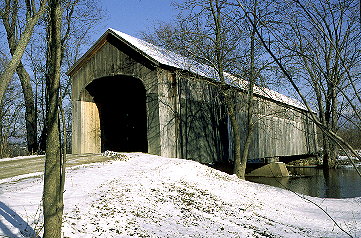
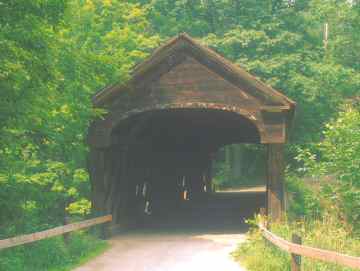
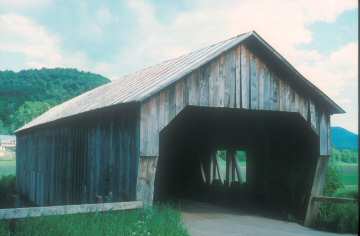
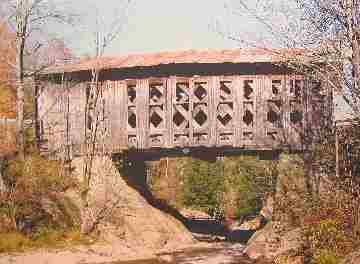
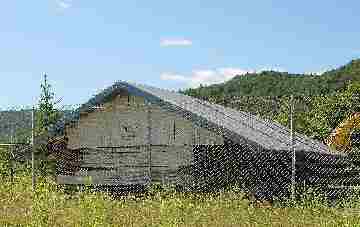
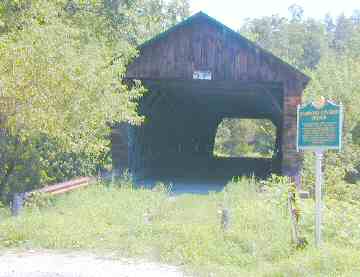
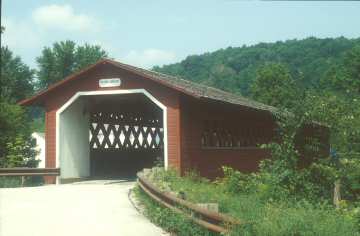




 Joe Nelson, P.O Box 267, Jericho, VT 05465-0267
Joe Nelson, P.O Box 267, Jericho, VT 05465-0267